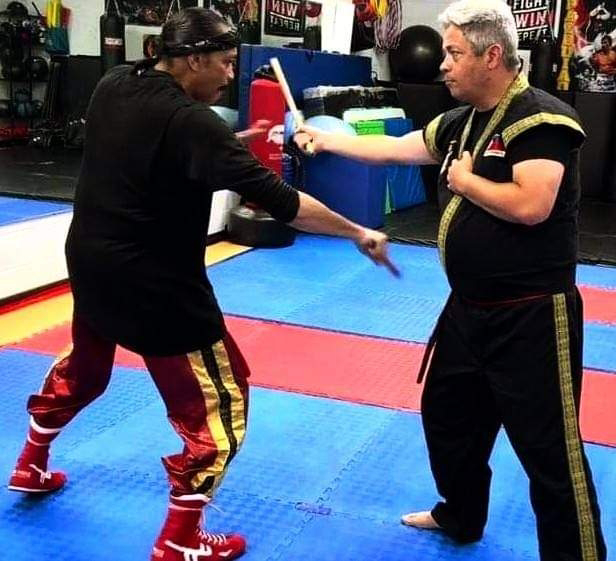Summary of The Recent UWSEF Boxing KaJuKenBo Escrima DC Serrada Escrima Workshop's Held in Santee, California 2024
---------------
Recently-In Santee, California, a spectacular martial arts event was held. Martial arts instructor's came from all around Southern California, Northern California, and as far away as the state of Ohio, in order to teach their various systems of martial arts at the 'Leaders of Tomorrow Martial Arts School' located in Santee, California. The promoter, and the host of the event was San Diego based instructor Grandmaster Professor Coach Heidi Sarmiento.
*The focus of the event was to bring forth more exposure to the school located in Santee, CA., and at the same time share various self-defense techniques that are designed for defending oneself if ever attacked by an assailant in the streets, or in any kind of an indoor dwelling space.
*The workshops began with the 'KaJuKenBo Escrima' method of self-defense as taught by Northern California UWSEF representative Grand Master David Ducay. GM Ducay, taught the participants various weapons, and empty hand counter tactics that can be effectively learned, and applied against any attacker (s) if and when it becomes necessary.
*Second up on the mat, was internationally renowned martial artist Maha Guru SGMD, who traveled all of the way from the state of Ohio, in order to support this unique event, and also to share his over 47 years of martial arts expertise. The Guru taught simple, quick, and easy to learn empty hand, and practical weapons techniques that are designed to stop an attacker dead in their tracks.
*Last up on the mat, was Grand Master Prof. Boxing Coach Heidi Sarmiento. GM Coach Sarmiento taught some of the more intricate aspects of the fine art of boxing. She emphasized many boxing drills that are designed to increase one's reflexes, eye and hand coordination, footwork, power, and flawless timing in delivering, and in countering hand strikes.
*Additionally, several other top notch distinctive martial arts dignitaries showed up for this historical affair. Inglewood, California based KAJUKENBO instructor Professor Rick Kingi, and his assistant instructor Professor Cliff Sumida came out to show their respects, and support for the visiting instructor's.
*Professor GM Kingi, has been involved in KAJUKENBO KARATE since the early 1960s. He was GGM Carlos Bunda’s first black belt. (He got his 1st. black belt degree in 1968). During the middle 1960’s, he was able to train under the late Grand Professor John Leoning, and the late Dave Kawashima.
*Also in attendance was Kempo Karate Professor Bryan Bagnas, of San Diego, who paid his respects by attending the gathering, and by participating in all three of the workshop's that were presented as well.
*The Grand finale of the workshop's event ended by presenting a special honor award to Filipino martial arts celebrity pioneer, Arnis Grandmaster Joe Cardenas, of National City, California.
*Grand Master Joe Cardenas was awarded the prestigious 'UWSEF HONORARY GRANDMASTER'S GOD FATHER'S AWARD.' The award was presented to, GM Joe Cardenas by Maha Guru SGMD, who is the presiding president, and the founder of the United World Serrada Escrima Federation (UWSEF). The UWSEF represents over 47 countries worldwide.
*Special thanks goes out to Aaron Hardin,
2 time California State Golden Gloves State Champion, and National Golden Gloves Bronze Medalist, who coached, and guided the participants patiently in some of the basic fundamentals of boxing.
*Also, thanks to Master Joe Abueg, who gave an outstanding full contact stick fighting demonstration along with his assistant instructor GM Professor Coach Heidi Sarmiento.
*Acknowledgements also goes out to Master Joe Benedito, Kristine Magat, and Jos Eff.
*This was indeed a very rare function in the Southern California area, and for all of those who missed this exciting, and grand affair, and who are interested in participating in the next upcoming Self-Defense Workshop's trilogy event in SoCal, can contact SoCal UWSEF Representative GM Prof. Coach Heidi Sarmiento at: heidi.wilson@gccc.edu
or Maha Guru SGMD at: checkpointproductions011@gmail.com







